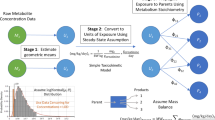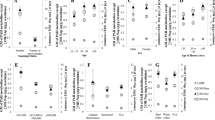Abstract
Purpose of Review
Urine- and serum-based biomarkers are useful for assessing individuals’ exposure to environmental factors. However, variations in urinary creatinine (a measure of dilution) or serum lipid levels, if not adequately corrected for, can directly impact biomarker concentrations and bias exposure-disease association measures.
Recent Findings
Recent methodological literature has considered the complex relationships between creatinine or serum lipid levels, exposure biomarkers, outcomes, and other potentially relevant factors using directed acyclic graphs and simulation studies. The optimal measures of urinary dilution and serum lipids have also been investigated.
Summary
Existing evidence supports the use of covariate-adjusted standardization plus creatinine adjustment for urinary biomarkers and standardization plus serum lipid adjustment for lipophilic, serum-based biomarkers. It is unclear which urinary dilution measure is best, but all serum lipid measures performed similarly. Future research should assess methods for pooled biomarkers and for studying diseases and exposures that affect creatinine or serum lipids directly.


Similar content being viewed by others
References
Papers of particular interest, published recently, have been highlighted as: • Of importance •• Of outstanding importance
Heavner DL, Morgan WT, Sears SB, Richardson JD, Byrd GD, Ogden MW. Effect of creatinine and specific gravity normalization techniques on xenobiotic biomarkers in smokers’ spot and 24-h urines. J Pharm Biomed Anal. 2006;40(4):928–42.
Phillips DL, Pirkle JL, Burse VW, Bernert JT, Henderson LO, Needham LL. Chlorinated hydrocarbon levels in human serum: effects of fasting and feeding. Arch Environ Contam Toxicol. 1989;18:495–500.
• Barr DB, Wilder LC, Caudill SP, Gonzalez AJ, Needham LL, Pirkle JL. Urinary creatinine concentrations in the U.S. population: implications for urinary biologic monitoring measurements. Environ Health Perspect. 2004;113(2):192–200. This is a seminal paper that provided evidence that creatinine levels are associated with various other factors, including age, sex, race, fat free mass, and body mass index. This paper is highly cited as justification for adjusting for creatinine as a covariate when assessing the health effects of environmental exposures measured in urine
Christensen K, Sobus J, Phillips M, Blessinger T, Lorber M, Tan YM. Changes in epidemiologic associations with different exposure metrics: a case study of phthalate exposure associations with body mass index and waist circumference. Environ Int. 2014;73:66–76.
•• O'Brien KM, Upson K, Cook NR, Weinberg CR. Environmental Chemicals in Urine and Blood: improving methods for creatinine and lipid adjustment. Environ Health Perspect. 2016;124(2):220–7. With the aid of directed acyclic graphs and simulation studies, these authors compared existing methods for creatinine and lipid adjustment with a new method, called covariate-adjusted standardization. They show that the new method is appropriate for assessing urinary biomarkers and that classical standardization works well for lipophilic, serum-based biomarkers
Buckley JP, Herring AH, Wolff MS, Calafat AM, Engel SM. Prenatal exposure to environmental phenols and childhood fat mass in the Mount Sinai Children's environmental health study. Environ Int. 2016;91:350–6.
Guo J, Su L, Zhao X, Xu Z, Chen G. Relationships between urinary antimony levels and both mortalities and prevalence of cancers and heart diseases in general US population, NHANES 1999-2010. Sci Total Environ. 2016;571:452–60.
Tsai HJ, Wu CF, Tsai YC, Huang PC, Chen ML, Wang SL, et al. Intake of phthalate-tainted foods and serum thyroid hormones in Taiwanese children and adolescents. Sci Rep. 2016;6:30589.
Wang W, Schaumberg DA, Park SK. Cadmium and lead exposure and risk of cataract surgery in U.S. adults. Int J Hyg Environ Health. 2016.
Boeniger MF, Lowry LK, Rosenberg J. Interpretation of urine results used to assess chemical exposure with emphasis on creatinine adjustments: a review. Am Ind Hyg Assoc J. 1993;54(10):615–27.
Hoet P, Deumer G, Bernard A, Lison D, Haufroid V. Urinary trace element concentrations in environmental settings: is there a value for systematic creatinine adjustment or do we introduce a bias? J Expo Sci Environ Epidemiol. 2016;26(3):296–302.
Suwazono Y, Akesson A, Alfven T, Jarup L, Vahter M. Creatinine versus specific gravity-adjusted urinary cadmium concentrations. Biomarkers. 2005;10(2–3):117–26.
Yeh HC, Lin YS, Kuo CC, Weidemann D, Weaver V, Fadrowski J, et al. Urine osmolality in the US population: implications for environmental biomonitoring. Environ Res. 2015;136:482–90.
Weaver VM, Kotchmar DJ, Fadrowski JJ, Silbergeld EK. Challenges for environmental epidemiology research: are biomarker concentrations altered by kidney function or urine concentration adjustment? J Expo Sci Environ Epidemiol. 2016;26(1):1–8.
Hauser R, Meeker JD, Park S, Silva MJ, Calafat AM. Temporal variability of urinary phthalate metabolite levels in men of reproductive age. Environ Health Perspect. 2004;112(17):1734–40.
Hays SM, Aylward LL, Blount BC. Variation in urinary flow rates according to demographic characteristics and body mass index in NHANES: potential confounding of associations between health outcomes and urinary biomarker concentrations. Environ Health Perspect. 2015;123(4):293–300.
Middleton DR, Watts MJ, Lark RM, Milne CJ, Polya DA. Assessing urinary flow rate, creatinine, osmolality and other hydration adjustment methods for urinary biomonitoring using NHANES arsenic, iodine, lead and cadmium data. Environ Health. 2016;15(1):68.
• Schisterman EF, Whitcomb BW, Buck Louis GM, Louis TA. Lipid adjustment in the analysis of environmental contaminants and human health risks. Environ Health Perspect. 2005;113(7):853–7. This is the first paper to apply a directed acyclic graph and simulation approach to the issue of serum lipid adjustment. This paper is highly cited as justification for adjusting for serum lipids as a covariate or using a two-stage model when assessing the health effects of lipophilic, environmental exposures measured in serum
Hunter DJ, Hankinson SE, Laden F, Colditz GA, Manson JE, Willett WC, et al. Plasma organochlorine levels and the risk of breast cancer. N Engl J Med. 1997;337(18):1253–9.
Li D, Longnecker MP, Dunson DB. Lipid adjustment for chemical exposures: accounting for concomitant variables. Epidemiology. 2013;24(6):921–8.
Costanza MC, Cayanis E, Ross BM, Flaherty MS, Alvin GB, Das K, et al. Relative contributions of genes, environment, and interactions to blood lipid concentrations in a general adult population. Am J Epidemiol. 2005;161(8):714–24.
Bernert JT, Turner WE, Patterson Jr DG, Needham LL. Calculation of serum “total lipid” concentrations for the adjustment of persistent organohalogen toxicant measurements in human samples. Chemosphere. 2007;68(5):824–31.
Bergonzi R, De Palma G, Tomasi C, Ricossa MC, Apostoli P. Evaluation of different methods to determine total serum lipids for normalization of circulating organochlorine compounds. Int Arch Occup Environ Health. 2009;82(10):1241–7.
Rylander L, Nilsson-Ehle P, Hagmar L. A simplified precise method for adjusting serum levels of persistent organohalogen pollutants to total serum lipids. Chemosphere. 2006;62(3):333–6.
Moriguchi J, Ezaki T, Tsukahara T, Furuki K, Fukui Y, Okamoto S, et al. Comparative evaluation of four urinary tubular dysfunction markers, with special references to the effects of aging and correction for creatinine concentration. Toxicol Lett. 2003;143(3):279–90.
Goncharov A, Haase RF, Santiago-Rivera A, Morse G. Akwesasne task force on the E, McCaffrey RJ, et al. high serum PCBs are associated with elevation of serum lipids and cardiovascular disease in a native American population. Environ Res. 2008;106(2):226–39.
Patel CJ, Cullen MR, Ioannidis JP, Butte AJ. Systematic evaluation of environmental factors: persistent pollutants and nutrients correlated with serum lipid levels. Int J Epidemiol. 2012;41(3):828–43.
Engel LS, Buckley JP, Yang G, Liao LM, Satagopan J, Calafat AM, et al. Predictors and variability of repeat measurements of urinary phenols and parabens in a cohort of shanghai women and men. Environ Health Perspect. 2014;122(7):733–40.
Meeker JD, Calafat AM, Hauser R. Urinary phthalate metabolites and their biotransformation products: predictors and temporal variability among men and women. J Expo Sci Environ Epidemiol. 2012;22(4):376–85.
Perrier F, Giorgis-Allemand L, Slama R, Philippat C. Within-subject pooling of biological samples to reduce exposure misclassification in biomarker-based studies. Epidemiology. 2016;27(3):378–88.
Lyles RH, Mitchell EM, Weinberg CR, Umbach DM, Schisterman EF. An efficient design strategy for logistic regression using outcome- and covariate-dependent pooling of biospecimens prior to assay. Biometrics. 2016.
Author information
Authors and Affiliations
Corresponding author
Ethics declarations
Conflict of Interest
Katie M. O’Brien, Kristen Upson, and Jessie P. Buckley declare that they have no conflict of interest.
Human and Animal Rights and Informed Consent
All reported studies/experiments with human or animal subjects performed by the authors have been previously published and complied with all applicable ethical standards (including the Helsinki declaration and its amendments, institutional/national research committee standards, and international/national/institutional guidelines).
Additional information
This article is part of the Topical Collection on Methods in Environmental Epidemiology
Rights and permissions
About this article
Cite this article
O’Brien, K.M., Upson, K. & Buckley, J.P. Lipid and Creatinine Adjustment to Evaluate Health Effects of Environmental Exposures. Curr Envir Health Rpt 4, 44–50 (2017). https://doi.org/10.1007/s40572-017-0122-7
Published:
Issue Date:
DOI: https://doi.org/10.1007/s40572-017-0122-7




